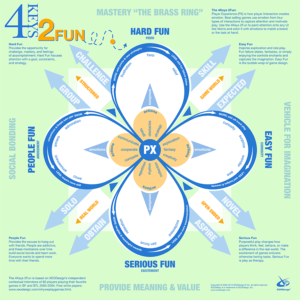Testing your design
How to know you are going in the right directionKnowing you are doing the right thing in #Gamification is really hard when you don’t have the right tools at hand. Now, the first thing you should keep in mind are your KPIs. These little guys will tell if ANY project is going in the right direction, however, one thing is the business side of the system and a different the gamified side. When building your system first hand, before ANY data comes in (which is ultimately the one and only compass you must follow) there are a couple of toys you can use to see the north:
Dynamics.
In our Game master framework, the first thing you do is build the game dynamics. Each of them provide a simple question to see if you have dealt with all basic components of a gamified system:
- Narrative > Why are the players here?
- Environment > How do the players feel? Are they playing together or against each other?
- Win State > How do you know you win/finish the game? At what point can I call a victory or a defeat?
- Progression > How do I know if I’m going forward or backwards? Do you provide enough feedback to your players?
- Relationships > How do players play between them and by themselves? Are there enough tools that will allow them to play?
- Boundaries > How long and where can the players play?
SAPS
Introduced by Gabe Zichermann, this simple model helps you check that your rewards are in place and well done:
- STATUS: It refers to a position of a player in relation to the rest. This DO NOT mean at any point better or worse. Status as a reward can be received in many different ways.
- ACCESS: Players gain access to information, items, objects, experiences or anything that NOT all players do. STATUS can grant ACCESS to some place (like a palace or the store in front) therefore killing two stones with one bird
- POWER: The word EMPOWERMENT applies too. The ability to do something not all players can. STATUS can grant ACCESS to information that gives the player POWER to make decisions other players can’t (for example)
- STUFF: Things not all players have. Things players earn by completing tasks, quests or challenges. STATUS can grant ACCESS to a place where the player has the POWER to use the information he earlier gained to earn STUFF they couldn’t get anywhere else.
When using SAPS make sure players receive rewards that are well rounded in all FOUR types. STUFF can be perceived as money (and it usually is). Not the best way to reward players because by human nature, MONEY IS NEVER ENOUGH!
4K2F
 Nicole Lazzarro made this amazing thing called the FOUR KEYS TO FUN where she explains FOUR different kinds of FUN:
Nicole Lazzarro made this amazing thing called the FOUR KEYS TO FUN where she explains FOUR different kinds of FUN:
- EASY FUN: Curiosity, surprise, wonder, awe. This are basic elements to consider. Everybody likes having simple fun.
- SERIOUS FUN: Excitement, Zen focus, engagement. The feeling you get when doing something you like.
- PEOPLE FUN: Amusement, Admiration, teamwork. Everything is more fun with someone else, right?
- HARD FUN: Frustration, Fiero, relief. How good does it feel when finishing off a hard project? There. That’s it.
Inclusion
This part refers to the player types and the differences. Make sure to include them in your design as well. We based our framework in the use of the HEXAD from Andrzej Marczewski. All details can be found in his website and in one of the following posts.
The Hexad covers basically 6 different type of players. Based on the work by Richard Bartle, Marczewski proposes four intrinsically motivated player types and 2 additional ones: The player/user type and the disruptor.
- Achiever: Motivated by MASTERY, this type of player will try to achieve EVERYTHING in the system (finish each and every quest). Think of them as the “A” student, always in front of the class, always studying. Favorite question: “Am I the only who read the instructions?”
- Philantropist: Motivated by PHILANTROPIC PURPOSE. Really important to make the difference. These players will want to help others just because they want to. They also like to be or lead teams in order to accomplish meaningful goals. Great Leaders. Favorite question: “Why won’t you separate plastic?”
- Socialiser: Motivated by RELATEDNESS, this players will want to connect with as many others as possible. They love social games, cooperation and competition as long as it means connecting with more players. Favorite question: “So what’s the best place to party around here?”
- Free-Spirit: Motivated by AUTONOMY they will want to follow their hearts through the game. They use their guts as guidance and love to explore EVERYTHING that seems explorable. Favorite question: “Can I go to the top of the mountain?”
Now, this are just 4 different ways to test your design. We are missing the most crucial one, but we’ll talk about it in another post. This one is already too long.

Bernardo Letayf
M.B.O. (Mind Behind the Operation)
6th position in the Gamification Gurus Power 100!
Gamification Keynote Speaker & the mind behind the operation @bluerabbit, a gamification platform for education.
Developed three frameworks to teach/learn how to create gamification systems and build gamified content
Declared a world wide war on grades.
